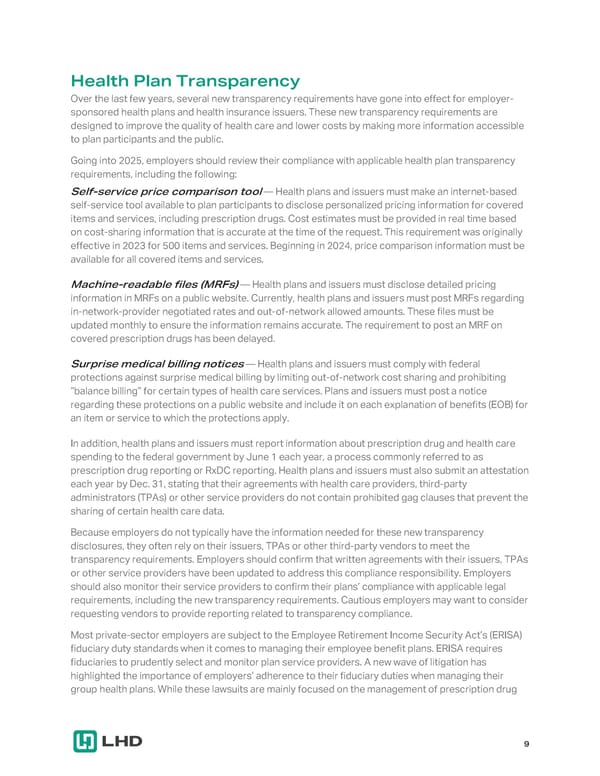Health Plan Transparency Over the last few years, several new transparency requirements have gone into effect for employer- sponsored health plans and health insurance issuers. These new transparency requirements are designed to improve the quality of health care and lower costs by making more information accessible to plan participants and the public. Going into 2025, employers should review their compliance with applicable health plan transparency requirements, including the following: Self-service price comparison tool — Health plans and issuers must make an internet-based self-service tool available to plan participants to disclose personalized pricing information for covered items and services, including prescription drugs. Cost estimates must be provided in real time based on cost-sharing information that is accurate at the time of the request. This requirement was originally effective in 2023 for 500 items and services. Beginning in 2024, price comparison information must be available for all covered items and services. Machine-readable files (MRFs) — Health plans and issuers must disclose detailed pricing information in MRFs on a public website. Currently, health plans and issuers must post MRFs regarding in-network-provider negotiated rates and out-of-network allowed amounts. These files must be updated monthly to ensure the information remains accurate. The requirement to post an MRF on covered prescription drugs has been delayed. Surprise medical billing notices — Health plans and issuers must comply with federal protections against surprise medical billing by limiting out-of-network cost sharing and prohibiting “balance billing” for certain types of health care services. Plans and issuers must post a notice regarding these protections on a public website and include it on each explanation of benefits (EOB) for an item or service to which the protections apply. In addition, health plans and issuers must report information about prescription drug and health care spending to the federal government by June 1 each year, a process commonly referred to as prescription drug reporting or RxDC reporting. Health plans and issuers must also submit an attestation each year by Dec. 31, stating that their agreements with health care providers, third-party administrators (TPAs) or other service providers do not contain prohibited gag clauses that prevent the sharing of certain health care data. Because employers do not typically have the information needed for these new transparency disclosures, they often rely on their issuers, TPAs or other third-party vendors to meet the transparency requirements. Employers should confirm that written agreements with their issuers, TPAs or other service providers have been updated to address this compliance responsibility. Employers should also monitor their service providers to confirm their plans’ compliance with applicable legal requirements, including the new transparency requirements. Cautious employers may want to consider requesting vendors to provide reporting related to transparency compliance. Most private-sector employers are subject to the Employee Retirement Income Security Act’s (ERISA) fiduciary duty standards when it comes to managing their employee benefit plans. ERISA requires fiduciaries to prudently select and monitor plan service providers. A new wave of litigation has highlighted the importance of employers’ adherence to their fiduciary duties when managing their group health plans. While these lawsuits are mainly focused on the management of prescription drug 9
 2025 Employee Benefits Market Outlook Page 8 Page 10
2025 Employee Benefits Market Outlook Page 8 Page 10